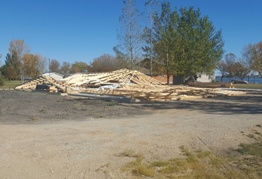Few things drive me nuts more than self- serving advice columns. In my humble opinion, if one is offering advice as an expert in a construction field they should be open to a plethora of possible design solutions.
The following article appeared October 1, 2016 at www.kpcnews.com and is copied in its entirety without edits:
“Pole buildings can be insulated
- I have a large pole building and want to temper the inside just above freezing. I want to park equipment so they will thaw out and also want to store liquids to keep from freezing. I have had friends that have spray foamed the inside and it has been very costly. I also read that the spray foam doesn’t want to be left exposed. I know it’s an age-old question but what is the cost effective way to insulate my pole building? — Ken of Churubusco
- There are several different approaches to insulating your pole building.Post footings do not provide a continuous thermal or structural footing so to think that the walls or ceiling of your pole building are going to have the same performance as a conventional built building is not correct.
 Yes, you can dig continuous footings between the posts and, yes, you can frame walls between the posts to try to emulate the characteristics of a conventional building but at that point probably you should have built it conventionally in the first place.
Yes, you can dig continuous footings between the posts and, yes, you can frame walls between the posts to try to emulate the characteristics of a conventional building but at that point probably you should have built it conventionally in the first place.
That being said, you’re looking to add some insulation to help with heat loss and to help air seal your pole building enough to be able to add some heat and lightly heat the building.
I am assuming the building has steel laid over wood purlins attached to posts basically 8 feet on center and the ceiling is open with trusses 4 feet on center. Closed cell foam is the best choice but costs more than open cell mainly to help stop moisture from soaking into the foam.
Normally I would, because of costs, use open cell foam and spray 2 inches to insulate and air seal. If additional insulation is desired then add fiberglass insulation with some sort of finish wall with a vapor barrier. The typical application is to line the ceiling with steel and blow cellulose insulation above to insulate the ceiling.
Jeff Deahl is past president of the Builders Association of Northeast Indiana. Questions for the Square Corners column may be submitted at ba-ni.com or email info@ba-ni.com”
I suppose what rankled me the most is the comment, “at that point probably you should have built it conventionally in the first place.” The author is a stick frame home builder, rather than having done the research, he is merely making suppositions.
It doesn’t take a rocket scientist to design a post frame (pole) building which is thermally efficient – more so than close to (if not all) conventionally stick framed buildings.
And the post frame building will be less expensive.
A building’s foundation system has nothing to do with the thermal performance of the walls and ceiling. To think so, is truly misguided and this author offers no proof, just a slap down.
Stick frame construction is less thermally efficient due to the tremendous number of framing members which are in contact with both the outside and inside walls. Post frame construction affords a deep wall insulation cavity and can be designed with fewer direct thermal transmission points (thermal bridges) than stick frame.
I don’t just blow smoke in my articles, I can back up what I write with evidence: https://www.hansenpolebuildings.com/2013/08/thermography/






